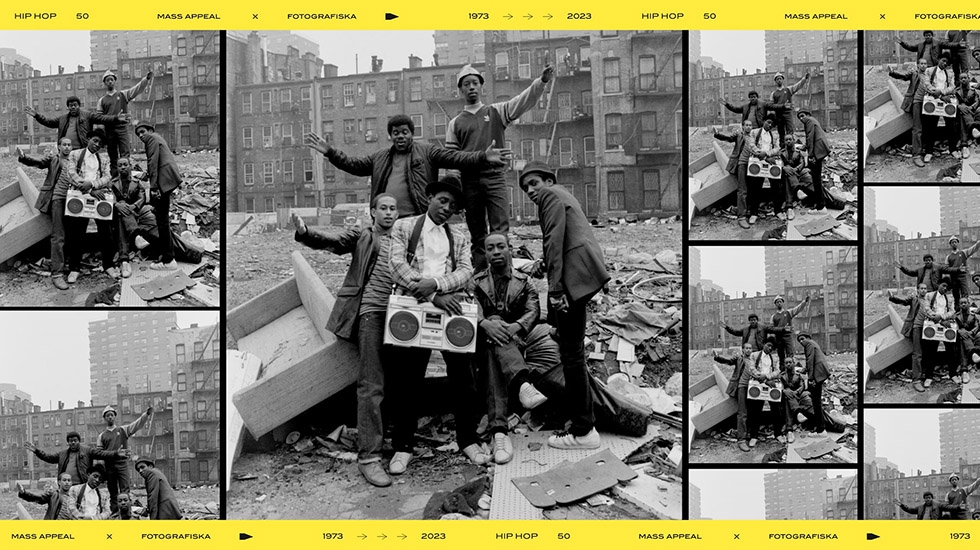From a then unconscious grassroots movement to a now global, and highly conscious, billion dollar industry. In connection with the hip-hop genre turning half a century, 50 years of music history are now shown at Fotografiska Stockholm. Hip-Hop: Conscious, Unconscious is a retrospective photo exhibition focusing on the American music scene, with everything from the earliest images of the burgeoning hip-hop scene of the 70s to contemporary portraits of some of the world’s most revered artists.
The exhibition features over 50 photographers, several of whom are well-known names such as Martha Cooper, Jonathan Mannion, Janette Beckman and Campbell Addy . Artists appearing include Nas, Mos Def, Wyclef Jean, Lauryn Hill, Erykah Badu, The Roots, Christopher “Biggie” Wallace, Run DMC, Wu-Tang Clan, Mary J. Blige, Missy Elliott, Queen Latifah, Kendrick Lamar and many more.
Sacha Jenkins:
– It’s easy to forget that there was a time before hip-hop was an industry that made money. From the beginning, it was young people just living their lives, trying to entertain themselves with limited resources and create an aesthetic that they themselves recognized. It wasn’t for the world, it was for a very specific group. Then there was an exponentially rapid transition where hip-hop culture became aware of itself as an incredibly lucrative, global export commodity. The lifeblood of the exhibition is the period before hip-hop itself knew what it was, says Sacha Jenkins , co-curator of the exhibition and Chief Creative Officer at Mass Appeal, who herself grew up in the New York hip-hop scene in the 1980s.
The birth of hip-hop dates to August 11, 1973 in New York when an 18-year-old guy who calls himself DJ Cool Herc has promised his little sister Cindy to play records at her party. She wants to buy new clothes for the start of school after the summer holidays, and prints flyers and sells tickets to the party in a meeting room in the Bronx district. On the two record players are two copies of James Brown’s LP Sex Machine. DJ Cool Herc starts the song Give It Up or Turnit a Loose on both turntables, but prolongs and mixes the various drum breaks while scratching with the needle over the vinyl records. What Cindy’s friends don’t know is that they have just witnessed the birth of a cultural revolution that will come to be known as hip-hop.
Several of the works now on display at Fotografiska are iconic images that have become their own milestones in hip-hop history, others are rare and unknown moments from what has become the most influential pop culture movement of modern times. The exhibition texts by Sacha Jenkins are interpreted in Swedish by the artist Jason “Timbuktu” Diakité and the journalist and hip-hop expert Ametist Azordegan contributes with texts about the development of hip-hop in Sweden.
– The exhibition both highlights individual creators and maps various themes – such as the women who paved the way in hip-hop’s male-dominated environment, hip-hop’s regional and stylistic diversification and the turning point when hip-hop became a billion-dollar industry that continues to create world artists. The exhibition is largely structured according to chronology and geography: the early years, the US East Coast, West Coast and South, and the newer wave of artists that have emerged since the early 2010s, says Mohamed Mire, exhibition producer at Fotografiska Stockholm.
The exhibition Hip-Hop: Conscious, Unconscious is created by Fotografiska in collaboration with Mass Appeal and will be shown at Fotografiska Stockholm from 20 October 2023 to 4 February 2024. The exhibition is curated by Sacha Jenkins , Chief Creative Office at Mass Appeal and Sally Berman , Visuals Director at Hearst Visual Group. With the support of Fotografiska International: Johan Vikner , Global Director of Exhibitions and Pauline Benthede , Global Vice President Exhibitions as well as Fotografiska Stockholm: Mohamed Mire , Exhibitions Manager and Lisa Giomar Hydén , Director of Exhibitions. The exhibition was shown for the first time last spring at Fotografiska in New York and broke attendance records and was noticed in media such as The New York Times, VICE, Vogue, The Guardian and many more.
Wyclef Jean and Lauryn Hill, East Harlem, New York City (1993)
PARTICIPATING PHOTOGRAPHERS:
Adama Delphine Fawundu, Adrienne Raquel, Ahmed Klink, Angela Boatwright, Anthony Mandler, Anthony “Supreme” Thompson, Brian “B+” Cross, Butch Belair, Campbell Addy, Catherine McGann, Charlie Ahearn, Chris Buck, Christian Weber, Christian Witkin, Claude Paradise Gray, Clay Patrick McBride, Danielle Levitt, Danny Clinch, David Corio, Diwang Valdez, Eddie Otchere, Ernie Paniccioli, Estevan Oriol, Geoffroy de Boismenu, George DuBose, Henry Chalfant, Jamel Shabazz, Jamil GS, Janette Beckman, Jean-Pierre Laffont, Jesse Frohman, Joe Conzo, Jonathan Mannion, Josh Cheuse, Kenneth Cappello, Lisa Leone, Martha Cooper, Matt Marzahl, Michael Levine, Mike Miller, Mike Schreiber, Nitin Vadukul, Phil Knott, Piotr Sikora, Ricky Flores, Ricky Powell, Sacha Waldman, Sam Balaban, Shawn Mortensen, Sophie Bramly, Sue Kwon, T. Eric Monroe, Theo Wenner, Thirstin Howl the 3rd and Travis Shinn.




